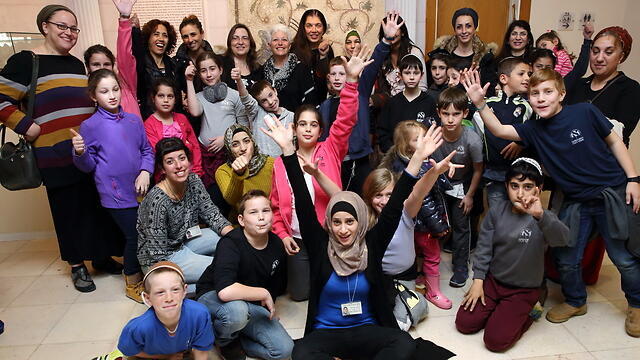The wave of terror roiling Israel in recent months has put Jewish-Arab relations to the test. But one Jerusalem museum is as determined as ever to meet the challenge.
For almost 20 years, the Bible Lands Museum has sponsored encounters and cooperative activities between Jewish Israeli schools and Palestinian Muslim schools through the “Image of Abraham” project.
Through the initiative, Jews and Arabs–students, teachers, and parents–learn together about the role of Abraham as the common Patriarch in Judaism and Islam. Through a series of museum visits, the children participate in a rich and exciting program that encourages working together in small, mixed Arab-Jewish groups. Together, they explore the museum galleries, discover the cultures of the ancient Near East, and trace common elements in Arab and Jewish heritage.
“The Bible Lands Museum is built for this sort of programming because we show the shared common heritage of this region like no other institution,” Amanda Weiss, the museum’s director and the initiator of the project told Tazpit Press Service (TPS).
According to Weiss, over the years the Image of Abraham project has brought together thousands of students, teachers, and parents. Even if the first encounters are challenging, the outcome has always been successful.
“When the children come to the first meeting, they are always quite intrepid, they are not entirely sure what they are walking into,” Weiss explained. “They only know they are going to meet “The Other” for the very first time. The Jews are going to meet Arabs, and the Arabs are going to meet Jews. At this point, they have nothing in common that we would think that neighbors in the same city would be able to share. But they come together to learn about their shared common heritage.”
To facilitate a flow of communication and cooperation between the schoolchildren, all activities, lecture games and tasks in the project are conducted bilingually in Hebrew and Arabic, as not all Jewish kids speak Arabic and not all Arab kids speak Hebrew.
After the initial encounter, each class of the participating school is paired with a peer Jewish or Arab class for a series of meetings. The atmosphere is one of equality and mutual respect, fostering discussions that explore common historical and even contemporary bonds. At the conclusion of the series of group visits to the museum, the program’s final event is a celebration involving students, their parents, and the teachers.
“This program is vital for building a future in which peaceful coexistence is an option. This project encourages the participants to build personal connections with one another and overcome negative stereotypes, to understand our similarities and respect our differences,” Amanda Weiss told TPS.
The unique coexistence education program created by the Bible Lands Museum is now in its 19th year and brings together the Jerusalem School, a Palestinian elementary school from the eastern Jerusalem neighborhood of Beit Hanina, and the Jewish religious elementary school in the West Bank settlement of Efrata. This is first time a religious Jewish school has participated in the project alongside a Palestinian school.
“Some of our students are still in touch with the children of the Jerusalem School,” Efrata school principal Gila Sadon told TPS. “Following the project, I introduced Arabic language studies into our school curriculum, hoping to break down the language barrier between the students and facilitate more long-term communication between them.”
“It feels wonderful to see Palestinian and Israeli kids coming together every week. Our kids never want it to end,” Susan Shadid, principal of the Jerusalem School, told TPS.
According to Shadid, the benefit of the project is not restricted only to the schoolchildren. Barriers are broken among the adults as well.
“There’s a wonderful added benefit that on the evening of the celebration, the parents are sitting together in the same room, looking at each other, meeting after their children have already developed amicable relations. Sometimes they sit together and talk and ask each other questions. It’s great for families, too,” Shadid explained.
The principals of both the Jewish and Palestinian schools have stated several times that their students were extremely sad when the program ended and are already discussing how to continue and expand the educational encounters.
Kamal Atila, spokesperson of the Ministry of Education’s non-Jewish education department, attended the closing celebration as the father of one of the students from the Palestinian school. He related his thoughts to TPS.
“This was a very challenging and interesting encounter. Beyond the educational value of the museum sessions, there is great importance in facilitating encounters between the children of both sectors, especially during this problematic period. Personally, my daughter really enjoyed the program, and that in itself is also very important,” Atila told TPS.
“I would call on all parents, Arab and Israeli, to take their children to the Bible Lands Museum and to participate in this project. It is an important project, and it’s important that people come here to see it and take part in it,” Atila concluded.


